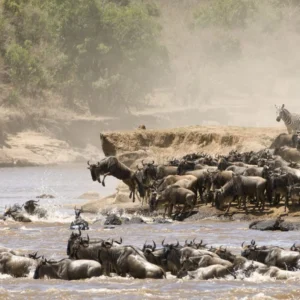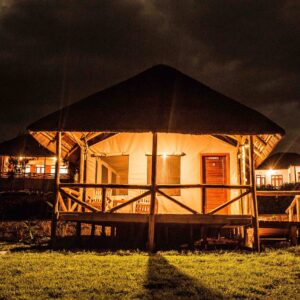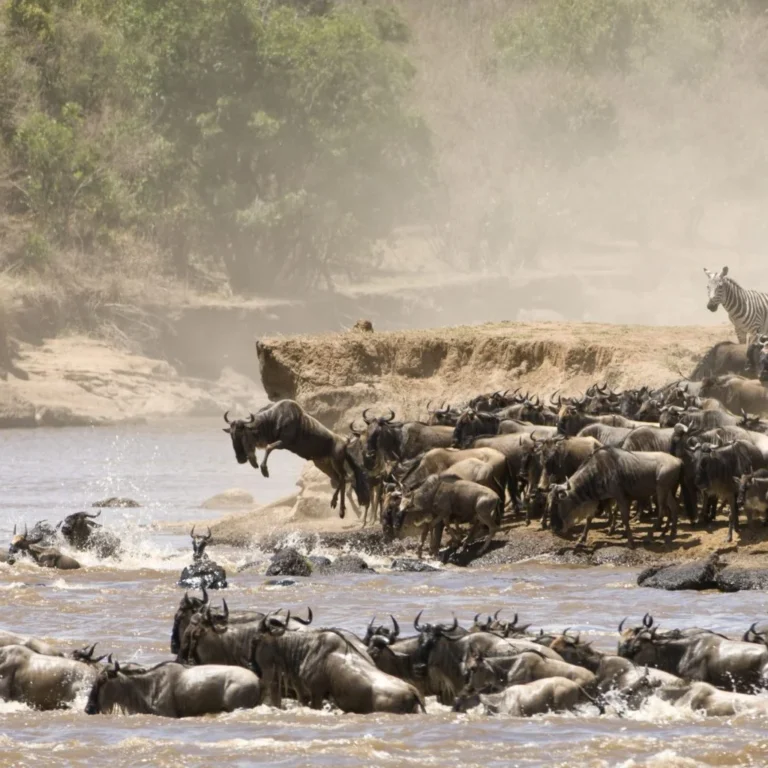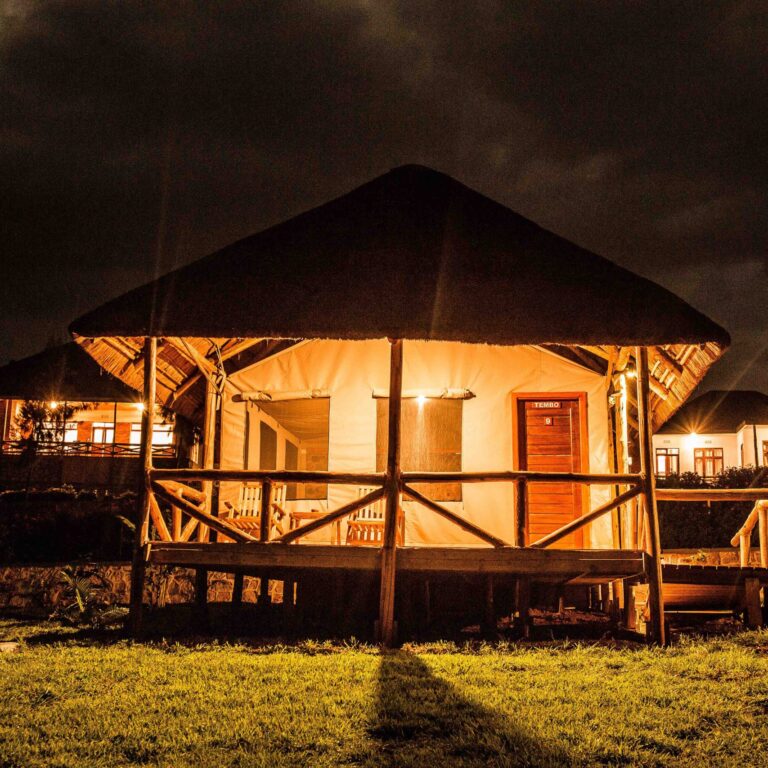Mount Kilimanjaro is considered a natural wonder due to its status as the highest mountain in Africa and the world’s tallest free-standing mountain, its unique and diverse ecosystems ranging from tropical rainforests to arctic summit zones, and the rare phenomenon of a snow-capped peak near the equator. Its sheer scale, isolation above surrounding plains, and incredible biodiversity contribute to its designation as a superlative natural phenomenon. Rising majestically from the plains of East Africa, Mount Kilimanjaro is more than just Africa’s highest peak; it is a profound testament to the Earth’s geological prowess and biological diversity, an undeniable natural wonder. Its snow-capped summit, seemingly defying its equatorial location, beckons adventurers and scientists alike, offering a unique blend of ecological marvels, geological narratives, and deep-rooted cultural significance.
Mount Kilimanjaro Height and Isolation – A Solitary Giant
Kilimanjaro’s most striking feature is its sheer scale and magnificent isolation. Standing at an impressive 5,895 meters (19,341 feet) above sea level, it is the highest freestanding mountain in the world. Unlike mountain ranges that are part of a continuous chain, Kilimanjaro erupts from the flat plains in splendid solitude. This isolation accentuates its colossal presence, making it a landmark visible from vast distances and creating its own localized weather patterns and ecological zones. It is the highest mountain in Africa (Uhuru Peak at 5,895 meters or 19,341 feet) and the tallest free-standing mountain globally, rising dramatically from the surrounding plains. This grand isolation also plays a crucial role in the evolution of its unique flora and fauna, as species have adapted to the distinct conditions found on its slopes, often developing endemic traits not found anywhere else.
Mount Kilimanjaro Diverse Ecosystems – A Vertical Safari
Ascending Kilimanjaro is akin to traversing an entire continent’s worth of ecosystems in a single journey. The mountain boasts an astonishing array of climatic zones, each supporting a distinct community of life. The journey begins in the cultivated lower slopes, giving way to lush rainforests teeming with diverse plant and animal life, including various monkey species and elusive leopards. Above the forest, a heath and moorland zone emerges, characterized by giant heathers and unique wildflowers. Higher still, the landscape transforms into an alpine desert, stark and beautiful, with sparse vegetation adapted to extreme conditions. Finally, the summit rears its head, a frigid arctic zone capped with glaciers and snow, a truly surreal experience at the equator. This vertical stratification of ecosystems, compressed into a single mountain, offers an unparalleled opportunity to observe ecological succession and adaptation in real-time.
Mount Kilimanjaro Near-Equator Snow Cap – A Paradox of Nature
Perhaps one of Kilimanjaro’s most iconic and perplexing features is its persistent snow and ice cap, despite being located just 3 degrees south of the equator. This anomaly is a direct consequence of its extreme height, which pushes its summit into the Earth’s upper atmosphere, where temperatures plummet. The prevailing winds carry moisture that falls as snow and ice, accumulating over millennia to form glaciers that cling to the summit. However, this magnificent spectacle is also a poignant indicator of global climate change, with the ice cap having significantly receded in recent decades. The presence of snow and glaciers at its summit, near the equator, is a rare and striking natural occurrence that contrasts sharply with the tropical climate below. The melting glaciers serve as a powerful visual reminder of humanity’s impact on the planet, making Kilimanjaro a vital subject of glaciological and climate research.
Mount Kilimanjaro Volcanic Formation – A Fiery Genesis
Kilimanjaro’s very existence is a testament to the powerful geological forces that shaped the East African Rift Valley. It is a stratovolcano, composed of three distinct volcanic cones: Kibo, Mawenzi, and Shira. Kibo, the highest, is a dormant volcano, while Mawenzi and Shira are extinct. Their formation involved millions of years of successive eruptions of lava, ash, and rocks, slowly building up the colossal edifice we see today. The volcanic soils are incredibly fertile, contributing to the rich biodiversity found on their lower slopes. Kilimanjaro in Tanzania is considered a natural wonder because: Specific landscape: It’s Africa’s largest mountain and stands by itself, making it a prominent feature of the landscape. The caldera on Kibo’s summit, a massive crater formed by collapse after a major eruption, offers a dramatic glimpse into the mountain’s fiery past, a constant reminder of the dynamic Earth beneath our feet.
Mount Kilimanjaro Biodiversity and Resources – A Living Treasure
Beyond its dramatic landscapes, Kilimanjaro is a crucible of biodiversity. Its varied ecosystems support a wide array of plant and animal species, many of which are endemic to the region. The mountain’s forests act as vital water catchments, feeding numerous rivers and streams that sustain local communities and wildlife for miles around. These water resources are crucial for agriculture and daily life in the arid plains below. Furthermore, the mountain’s rich volcanic soils support thriving coffee plantations on its lower slopes, contributing significantly to the local economy. The preservation of Kilimanjaro’s natural resources is therefore not just an ecological imperative but also an economic and social necessity for the surrounding region.
Kilimanjaro Cultural Significance – A Sacred Sentinel
For centuries, Mount Kilimanjaro has held profound cultural significance for the local Chagga people and other indigenous communities living in its shadow. It is not merely a mountain but a sacred entity, deeply interwoven with their mythology, spirituality, and daily lives. Legends speak of deities residing on its peaks, and its presence influences rituals, traditions, and a deep respect for nature. The mountain serves as a symbol of strength, resilience, and connection to the land. Its majestic presence has also inspired countless explorers, artists, and writers from around the globe, becoming a global icon of natural beauty and adventure. Mount Kilimanjaro is special due to its status as the tallest free-standing mountain in the world, rising to 5,895 meters (19,341 feet) above sea level in Tanzania. It is also Africa’s highest peak and a dormant volcano composed of three volcanic cones: Kibo (the summit), Mawenzi, and Shira.
Is Kilimanjaro one of the seven wonders of the world?
Kilimanjaro is widely recognized as one of the Seven Natural Wonders of Africa and is often included in lists of the world’s most remarkable natural features, though it is not part of the commonly cited “Seven Wonders of the World” list, which typically refers to ancient structures or man-made marvels. It is also one of the “Seven Summits,” the highest mountains on each continent.
What is the nature of the mountain Kilimanjaro?
Mount Kilimanjaro is a dormant stratovolcano and the highest free-standing mountain in Africa, composed of three distinct volcanic cones: Kibo, Mawenzi, and Shira. While Mawenzi and Shira are extinct, Kibo, the highest peak, is considered dormant and could potentially erupt again, though its last significant eruption was about 360,000 years ago. when will Mount Kilimanjaro erupt again? Mount Kilimanjaro is a dormant volcano and is not expected to erupt again anytime soon. While Kibo, the highest cone of Kilimanjaro, is classified as dormant, meaning it has the potential to erupt in the future, there are no current signs of imminent volcanic activity.
How was Mount Kilimanjaro formed? When did it last erupt?
Mount Kilimanjaro was formed by volcanic activity along the East African Rift, primarily from the accumulation of lava and ash over hundreds of thousands of years from its three distinct volcanic cones: Shira, Mawenzi, and Kibo. The last major eruption of Mount Kilimanjaro occurred approximately 360,000 years ago, though smaller volcanic activity may have occurred as recently as 200,000 years ago.
Which of these natural wonders of the ancient world is in Tanzania?
According to most sources, the natural wonder in Tanzania is Mount Kilimanjaro. Explanation: Mount Kilimanjaro is a towering volcano in Tanzania, considered one of the most iconic natural wonders due to its immense size and snow-capped peak. Is Kilimanjaro one of the seven wonders of the world? What is so special about it? Well, first, the fact that Kilimanjaro is one of the seven summits. The highest mountain in Africa and one of the 7 natural wonders of the world. The mountain and experience are unique, hiking through 5 climatic zones on a freestanding mountain.
What is so special about Kilimanjaro?
Mount Kilimanjaro is special because it is Africa’s highest peak and the world’s tallest free-standing mountain, standing independently from any mountain range. Its also one of the famous Seven Summits, the highest peaks on each continent, and known for being an accessible trekking mountain that doesn’t require technical climbing skills. From lush rainforests to alpine meadows, the slopes of Kilimanjaro are home to a wide range of habitats, each supporting its unique array of plant and animal life. This rich tapestry of biodiversity is a testament to the mountain’s ecological significance and its importance as a haven for wildlife.
What is the biggest natural wonder in the world?
The highest peak on Earth, capping the Himalayas and separating the plains of the Indian subcontinent from the Tibetan Plateau. Mount Everest was first climbed in 1953, and while it may have become easier than ever to visit, it remains a natural wonder. Most people believe it to be the European pronunciation of a KiChagga phrase meaning ‘we failed to climb it’, the name Kilimanjaro, commonly accepted as a mix of the Swahili word Kilima, meaning mountain, and the KiChagga word Njaro, which translates as whiteness. When you combine them, you get “Mountain of Whiteness.
What is the nature of the mountain Kilimanjaro?
Mount Kilimanjaro is a dormant, massive stratovolcano in Tanzania, standing as the highest mountain in Africa and one of the highest free-standing mountains globally, composed of three volcanic cones: Kibo, Mawenzi, and Shira. While Kibo, the highest peak and the central cone, dormant and could potentially erupt again. Mawenzi and Shira considered extinct. Mount Kilimanjaro is a stratovolcano, also known as a composite volcano. This means it’s a tall, cone-shaped volcano built up by layers of hardened lava, volcanic ash, and rock from past eruptions. It’s made up of three volcanic cones: Kibo, Mawenzi, and Shira.
What are the Seven Natural Wonders of Africa?
The Seven Natural Wonders of Africa are: the Nile River, Mount Kilimanjaro, the Sahara Desert, the Serengeti Migration, the Ngorongoro Crater, the Okavango Delta, and the Red Sea Reef. These natural wonders showcase Africa’s diverse landscapes and ecosystems. Visiting Kilimanjaro offers a unique and rewarding experience, with compelling reasons including its status as one of the “Seven Summits,” a profound sense of personal accomplishment, stunning natural beauty, the opportunity to support the local economy, and its significance as a site for climate change research and personal growth.
What is the physical description of Mount Kilimanjaro?
Mount Kilimanjaro is a massive, dormant volcanic mountain in Tanzania, Africa’s highest peak at 5,895 meters (19,340 feet) and the world’s largest free-standing mountain, characterized by its three distinct cones: Kibo, Mawenzi, and Shira, and a prominent, though rapidly disappearing, snow and ice cap. Rising dramatically from the surrounding plains, it features five distinct ecological zones as one ascends, from cultivated farmlands and rainforests at lower elevations to heath, alpine desert, and finally an arctic summit zone with glaciers.
What is the environment of Mount Kilimanjaro?
Mount Kilimanjaro’s environment characterized by five distinct ecological zones. Mount Kilimanjaro’s five surprising climate zones each with unique climate conditions, flora, and fauna, ranging from lush rainforests at lower elevations to a harsh, icy arctic zone at its summit. Climbing Mount Kilimanjaro offers a unique combination of personal accomplishment, breathtaking natural beauty, and cultural significance, making it a compelling expedition. As the world’s tallest freestanding mountain and Africa’s highest peak, it provides a challenging yet rewarding adventure and a chance to witness diverse ecosystems and wildlife unlike anywhere else on Earth.
Is a volcano a natural wonder?
Paricutin Volcano, located in the Mexican state of Michoacán, is one of the most extraordinary natural phenomena in the world. Recognized, one of the 7 natural wonders of the world, Paricutin famed for being the youngest volcano on Earth, whose birth was witnessed and recorded by humans. With its phenomenal views, out-of-this-world trekking experience that feels like walking from the Equator to the North Pole. The year-round snow-covered mountain surrounded by dry savannah and incredible life forms, Mount Kilimanjaro deemed the “Greatest Natural Wonder of the World.
Why is the Mount Kilimanjaro Important?
Mount Kilimanjaro is important due to its status as Africa’s highest peak and the world’s tallest freestanding mountain, its vital role as a source of freshwater for surrounding areas, its rich biodiversity and diverse ecosystems, its cultural significance to local communities, and its immense appeal for adventure tourism and scientific study. Mount Kilimanjaro, Africa’s highest peak, is a fascinating dormant volcano with many unique features. It’s the tallest free-standing mountain in the world, and its summit, Uhuru Peak, offers stunning views. It’s also part of the “Seven Summits” challenge for climbers.
In conclusion:
Mount Kilimanjaro’s status as a natural wonder is undeniable. Its solitary grandeur, breathtaking ecological diversity, enigmatic snowcap near the equator, dramatic volcanic genesis, abundant biodiversity and vital resources, and profound cultural significance all converge to create a truly unparalleled masterpiece of nature. It stands as a powerful reminder of Earth’s intricate processes and the urgent need to protect its precious natural heritage for generations to come. The primary “mystery” of Mount Kilimanjaro centers around the uncertain origins and meaning of its name. Which has been debated by historians and linguists for centuries, though it’s widely accepted to be a combination of words from local dialects. Additionally, the rapid melting of its iconic glaciers and ice cap due to climate change presents a significant environmental mystery and concern for scientists and observers.






